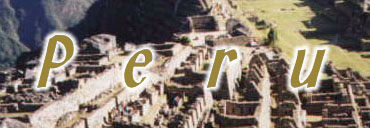
From July 8th to August 4th, 1998, truk and
Katherine traveled through various areas of central,
southern and coastal Peru, northwestern Bolivia, and northern Chile. The
following text is
taken from their diaries, with truk's writing in a normal font and Katherine's
in italics.
If you have an corrections or comments, please email
them to us [truk@truk.com].
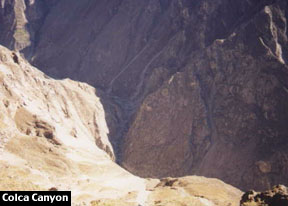 4 Augusto 1998 (COLCA CANYON; written in LIMA). Today we
depart for the States, but while Kath and I are definitely ready to be home
for a while, we are left with the strong feeling that we will miss this
place. Not Lima, in particular. Rather, the whole culture, the guys that
sell candy and cigarettes in the stalled traffic on the expressways, the
cops that are so bored they fight amongst each other to help find this or
that museum, the movie theaters that show a Disney flick and a porno as
a double-feature. We are already feeling the desire to return, and we have
yet to leave.
4 Augusto 1998 (COLCA CANYON; written in LIMA). Today we
depart for the States, but while Kath and I are definitely ready to be home
for a while, we are left with the strong feeling that we will miss this
place. Not Lima, in particular. Rather, the whole culture, the guys that
sell candy and cigarettes in the stalled traffic on the expressways, the
cops that are so bored they fight amongst each other to help find this or
that museum, the movie theaters that show a Disney flick and a porno as
a double-feature. We are already feeling the desire to return, and we have
yet to leave.
The ride was long and bumpy! 5 hours to Chivay. We stopped at several points along the way to see things - the Vecuna Sanctuary was first. It was difficult to see them because they are a bit skiddish and stayed far away fro the tourists. The sanctuary is actually a vecuna, llama, and alpaca sanctuary and we saw many of the llamas and alpacas as we rode up toward Chivay. The canyon is high and we passed over a point almost 5000 meters. There are two active volcanoes there, as well as some dormant ones. As we climbed the canyon, the roads go worse and worse - bumpier and bumpier. Before we got to Chivay, we stopped at an overlook where you could see the town below and the terraces around.
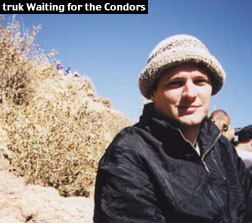 Chivay is a small town and, supposedly to avoid
the crowds, we had lunch at 4 pm at one of the hotels . It was a bit expensive,
but Stacy tried the alpaca, a local specialty. After eating, those that
choose to, could go to the hot spring pool area. 30 to 40 degree Celsius
waters with natural calcium, sulfur, iron etc. Who am I to turn down a hot
bath experience? The source of the water is a volcano heated stream which
comes out at about 80 degrees Celsius, but because it flows into the pool
area through open air channels cools to between 30-40 degrees. The water
was delightful and I spent my time there chatting with Frek, a guy from
Holland, and Hugo and Diane and friend of theirs from England. Being the
bath person that I am, I was the last out of the water and had to hurry
to dress. It was warm even outside of the water, although the temperature
was probably around 40 degrees F. I didn't get cold until I took a shower
at the hotel. The water was tepid at best and now I have a bit of a cold
from the whole experience. We had dinner and folk music entertainment at
another hotel around the street from where we were staying. The music played
while we ate and people danced. I had fresh trout and tomato soup. Stacy
has alpaca again. The music was ok, but for the most part, Peruvian folk
music gets old after about 20 minutes.
Chivay is a small town and, supposedly to avoid
the crowds, we had lunch at 4 pm at one of the hotels . It was a bit expensive,
but Stacy tried the alpaca, a local specialty. After eating, those that
choose to, could go to the hot spring pool area. 30 to 40 degree Celsius
waters with natural calcium, sulfur, iron etc. Who am I to turn down a hot
bath experience? The source of the water is a volcano heated stream which
comes out at about 80 degrees Celsius, but because it flows into the pool
area through open air channels cools to between 30-40 degrees. The water
was delightful and I spent my time there chatting with Frek, a guy from
Holland, and Hugo and Diane and friend of theirs from England. Being the
bath person that I am, I was the last out of the water and had to hurry
to dress. It was warm even outside of the water, although the temperature
was probably around 40 degrees F. I didn't get cold until I took a shower
at the hotel. The water was tepid at best and now I have a bit of a cold
from the whole experience. We had dinner and folk music entertainment at
another hotel around the street from where we were staying. The music played
while we ate and people danced. I had fresh trout and tomato soup. Stacy
has alpaca again. The music was ok, but for the most part, Peruvian folk
music gets old after about 20 minutes.
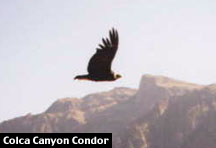 The Colca Canyon tour went very well, but all of the English-speakers
on our bus agreed that the direct trip, which leaves Arequipa at 3 in the
morning and gets back at 6 pm, would be a much better choice. We journeyed
all day in a dusty tour bus over dusty roads looking at dusty animals, houses,
villages and people. We peaked at over 4,800 meters, stopping long enough
to lose our breaths and stack a few rocks on top of one another, as is the
tradition there when you are bored and there are stackable rocks just lying
around. In Chivay, where the tours stop for the night, we were treated to
a little alpaca late lunch and Kath headed off to bathe in the hot baths
just outside of town. Sometime during the dinner later that night, in the
middle of the "complementary live music," it occurred to me that
they should have called this tour the "Bunch-of-Stuff-You-Wouldn't-Pay-For-Unless-We-Called-It-Something-Cool
Tour."
The Colca Canyon tour went very well, but all of the English-speakers
on our bus agreed that the direct trip, which leaves Arequipa at 3 in the
morning and gets back at 6 pm, would be a much better choice. We journeyed
all day in a dusty tour bus over dusty roads looking at dusty animals, houses,
villages and people. We peaked at over 4,800 meters, stopping long enough
to lose our breaths and stack a few rocks on top of one another, as is the
tradition there when you are bored and there are stackable rocks just lying
around. In Chivay, where the tours stop for the night, we were treated to
a little alpaca late lunch and Kath headed off to bathe in the hot baths
just outside of town. Sometime during the dinner later that night, in the
middle of the "complementary live music," it occurred to me that
they should have called this tour the "Bunch-of-Stuff-You-Wouldn't-Pay-For-Unless-We-Called-It-Something-Cool
Tour."
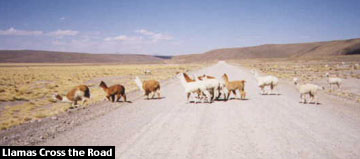 When we finally arrived at the Colca Canyon, or, actually this curve
in the road that just happens to be the best place to see the canyon, we
were wonderstruck. Perhaps it had something to do with the distance traveled
to get there, but we were suddenly glad we had come. The canyon is not so
much a traditional canyon as a deep river basin, but you really don't care
when confronted with the view from the edge. Huge condors, the largest birds
in the world, circle above your head. As if sitting on a ledge thousands
of feet above a white-water river while forty pound flying scavengers .circle your head isn't enough, you immediately
remember the guide saying something about how condors occasionally knock
baby sheep and vicunas over a cliff and come back later to munch on the
leftovers. It does have the effect of making you hold on just a little tighter.
On the way through the canyon, there are small openings to caves only discovered
about twenty years ago. Inside, workmen found mummies dating back to pre-Incan
times.
When we finally arrived at the Colca Canyon, or, actually this curve
in the road that just happens to be the best place to see the canyon, we
were wonderstruck. Perhaps it had something to do with the distance traveled
to get there, but we were suddenly glad we had come. The canyon is not so
much a traditional canyon as a deep river basin, but you really don't care
when confronted with the view from the edge. Huge condors, the largest birds
in the world, circle above your head. As if sitting on a ledge thousands
of feet above a white-water river while forty pound flying scavengers .circle your head isn't enough, you immediately
remember the guide saying something about how condors occasionally knock
baby sheep and vicunas over a cliff and come back later to munch on the
leftovers. It does have the effect of making you hold on just a little tighter.
On the way through the canyon, there are small openings to caves only discovered
about twenty years ago. Inside, workmen found mummies dating back to pre-Incan
times.
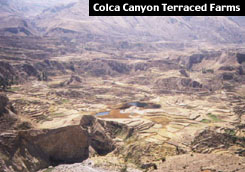 Continuing on, we reached the Condor Lookout
around 9:00 am. We could see the depth of the canyon well from this place.
There were about 100-150 tourists all waiting to see the condors. They did
not disappoint. There were about five active in the area within the view.
Three adults and two young birds.
Continuing on, we reached the Condor Lookout
around 9:00 am. We could see the depth of the canyon well from this place.
There were about 100-150 tourists all waiting to see the condors. They did
not disappoint. There were about five active in the area within the view.
Three adults and two young birds.
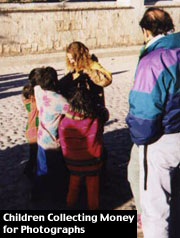 Kath and I got to see a strange sight in a small village early that
morning. The bus stopped to let us take pictures of the church in small
village square. Little kids gather at these spots where they hope you will
take a picture of them and give them some change. By the time we were about
to get back on the bus, the kids had grown in number such that it was just
about impossible to pay them all something for the pictures. Some of the
kids simply starting mobbing the photographers who didn't drop a coin in
each open, grabbing hand. Some of the foreigners just turned and ran from
the six to ten year old children, as if they were fleeing a robber.
Kath and I got to see a strange sight in a small village early that
morning. The bus stopped to let us take pictures of the church in small
village square. Little kids gather at these spots where they hope you will
take a picture of them and give them some change. By the time we were about
to get back on the bus, the kids had grown in number such that it was just
about impossible to pay them all something for the pictures. Some of the
kids simply starting mobbing the photographers who didn't drop a coin in
each open, grabbing hand. Some of the foreigners just turned and ran from
the six to ten year old children, as if they were fleeing a robber.
Lima
-> Huancayo -> Ayacucho
-> Cuzco -> Machu Picchu/Puno
-> Lake Titicaca ->
La Paz -> Arequipa
-> Colca Canyon -> Nazca/Pisco/Lima